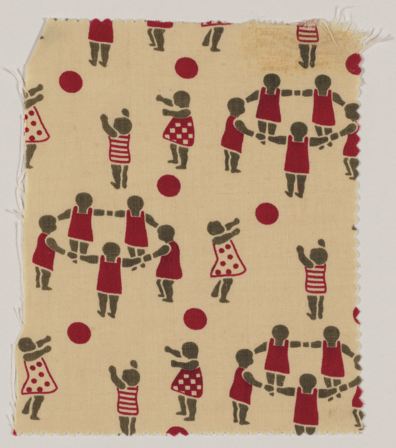You say you want a revolution? Well, yeah, if it means deporting the bunnies and the ducks to the gulag and decking the kid out in adorable prints of the Motherland's glorious steamrollers and tractors, well, paint me read and call me a Bolshevik, I'm there.

The Boston Museum has a show up right now through January 2007 that sheds a little light on a shortlived and unheard of [by me, anyway] design movement, "Designing the Modern Utopia: Soviet Textiles from the Lloyd Cotsen Collection."
As the exhibition's intro explains, the designs were part of the Bolsheviks' all-encompassing push to remake Russia into a modern, industrialized power:
In addition to industry, technology, electrification, and collectivized agriculture [yeah!], labor and sports would serve as historical-baggage-free themes for a newly modern, classless society. It didn't quite work out that way, unfortunately, but there are some pretty incredible deisgns that, if they were ever to surface on some baby or nursery gear today, would definitely cause a revolution:In 1928, a small but influential group of artists began to promote the use of thematic designs on textiles. They believed that printing tractors, smokestacks, and other modern motifs on clothing and on household fabrics such as pillowcases and curtains would not only have an educational value—by presenting the goals of the new state—but would also raise the wearer’s political consciousness and assist in the transformation of that individual into the ideal Soviet person In this uniquely Soviet experiment in social and sartorial engineering, workers and peasants—simply by putting on their shirts or skirts—potentially became walking billboards for the revolutionary initiatives being enacted by the first socialist government.

On December 18, 1933, the Council of People’s Commissars, the Soviet equivalent of the United States’ White House Cabinet, published a resolution titled Inadmissability of the Goods Produced by a Number of Fabric Enterprises Using Poor and Inappropriate Designs, thus putting an end to thematic textile design. There were two primary reasons for this proclamation: one, the infighting about appropriate designs and subjects for fabrics actually slowed down textile manufacturing and the distribution of desperately needed clothing to the nation’s citizens; and two, the citizens generally refused to buy or wear these propagandistic garments and household fabrics. While Soviet citizens may have tolerated the hyperbolic messages they encountered in posters, literature, and films about Soviet progress, perhaps hydroelectric dams on their pillowcases was too much to bear.Designing The Modern Utopia: Soviet Textiles from the Lloyd Cotsen Collection, runs through Jan 21, 2007 at the Boston Museum [mfa.org] Buy the exhibition catalogue at Amazon [amazon] images credit: Lent by Lloyd Cotsen; Courtesy, Museum of Fine Arts, Boston


They also produced some pretty amazing ceramics. Check it out.
CG3